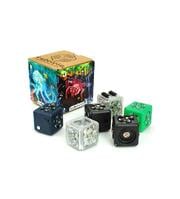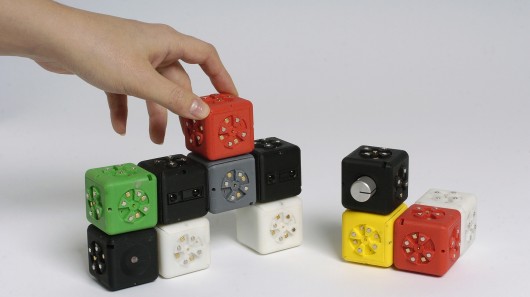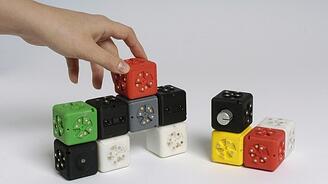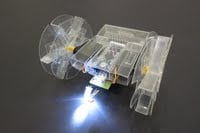RobotLAB Blog
Everything You Need To Know About Robotics in Businesses
Soccer + robots = A winning combination! RoboCup 2014 is coming
This year the Soccer World Cup will be played in Rio de Janeiro, Brazil. The crowds, as always, will be huge. After all, everyone wants to go to Rio de Janeiro and a World Cup is as good an excuse as any. The first game will be on Thursday, June 12th, between Brazil and Croatia. Those of you who dislike crowds might want to miss this competition; but don’t worry, if you’re looking for an excuse to boogie on down to Brazil there is an even more important soccer event occurring a month later a little north of Rio in João Pesso. I'm referring, of course, to RoboCup 2014 -- the Robot Soccer World Cup!
Actually, João Pessoa is more than a little north of Rio -- 1,223 miles north, to be precise. But that means three hours less flying time in a cramped airplane seat. And if you can believe the image on the Internet, João Pessoa appears to be on a bay as beautiful as Rio’s. More, it’s reputedly a safe city...a claim Rio de Janeiro certainly can’t make!
- 0 Comments
- Jun 9, 2014 12:58:15 PM
- Posted by Charles Nimrad
- Topics: Robotics, EdTech, 21st Century Classroom, International News, Project Based Learning
ISTE Honors Education Leaders
From: Silicon Beings of RobotsLAB
San Francisco, California
TO:Honored Winners of The 2014 ISTE Award
In Care of The International Society for Technology in Education
South Africa, Canada, Turkey, USA and Beyond
To all the winners of the International Society for Technology in Education 2014 Awards (ISTE), we, the assembled robots of RobotsLAB, salute you! Without human educators like you to guide us, our own silicon-being efforts to improve and enhance STEM education would go nowhere
- 0 Comments
- Jun 4, 2014 1:46:00 PM
- Posted by Charles Nimrad
- Topics:
Cubelets in the Classroom -- A Recipe for Education and Play
Mr Jaravata gets it! Engagement is the key to learning. Nothing engages kids like robots! And CUBELETS are engaging robots from which young kids can both enjoy and learn.
Fred Jaravata is a San Francisco Bay area educator who realizes that robots are the way to kids' minds.

According to his blog post ‘Our Students Playing With Cubelets,’ he recently decided to try CUBELETS after a period of working with Lego Mindstorm. He didn’t tell the kids much about the cubes he was giving them and kept directions to a minimum; he wanted to see what would happen naturally.
For those of you not familiar with CUBELETS, every cube has a different function. Some move the robot, some sense temperature or distance, some act like a flashlight. The cubes snap together magnetically and the trick is to snap them together in a fashion that forms an autonomous robot capable of movement in tune with its environment as indicated by its sensors. Kids have made everything from slithering snakes to writing robots with them.
- 0 Comments
- Jun 3, 2014 12:00:00 PM
- Posted by Charles Nimrad
- Topics: Robotics, EdTech, 21st Century Classroom, Middle School
Makerbot Steps Back in Time with Jurassic-Themed Models

Looking for a Tyrannosaurus rex figure for your home or classroom and the $8.36 million price tag (paid for Sue, the largest, best preserved Tyrannosaurus Rex ever found) seems a bit high for your budget? Then how does $14.99 at the MAKERBOT DIGITAL STORE for an anatomically correct, realistic, scale model of a full Tyrannosaurus Rex skeleton sound? Not only is the MAKERBOT Tyrannosaurus Rex model a lot less of a budget buster, but it's going to be a lot easier to lug from classroom to classroom -- even in death, Sue’s skeleton weighs 3922 lbs.
MAKERBOT, as you are probably aware, makes affordable desktop 3-D printers and scanners for the home, the classroom and for businesses. These products have won top awards from Popular Mechanics, Time Magazine and Popular Science. Working with their products keeps kids engaged in the moment and learning as they go. The MAKERBOT Tyrannosaurus Rex for example, allows students the chance to become involved with the new manufacturing paradigm called Additive Manufacturing -- it creates products through sequential layering, much as the natural world does. “3D printing,” says President Obama, “has the potential to revolutionize the way we make almost everything.”
- 0 Comments
- May 30, 2014 12:00:00 PM
- Posted by Charles Nimrad
- Topics: EdTech, 21st Century Classroom, Project Based Learning
Self Assembling Robotic Building Blocks!
CUBELETS, the new robot digital teaching aid for K-4 by RobotsLAB, is much more than just an entertaining toy. The included digital curriculum makes it a fun and engaging way for younger students to learn procedural thinking, pattern recognition, abstraction and the experience of developing a step-by-step strategy for solving problems.

CUBELETS are small magnetic blocks easily and safely handled by children that snap together to form an endless variety of robots capable of responding with lifelike behaviors to light, sound, temperature and other environmental pressures. There is no need to connect wires or program, and yet these little blocks herald the approach to the classroom of the latest advance in the science of robotics,Swarm Intelligence (SI).
- 0 Comments
- May 29, 2014 12:00:00 PM
- Posted by Charles Nimrad
- Topics: EdTech, 21st Century Classroom
Students love the cubelets
Do kids enjoy playing with CUBELETS? Perhaps more important, do they actually learn something while playing with CUBELETS? If we can believe the teachers who have reviewed their interactions with them on the Internet, the answer to both questions would seem to be a resounding yes!
A Canadian teacher for instance was surprised how excited the kids in his elementary class were at the thought of getting their hands on these CUBELETS. They had watched a video and begged him to get some. What particularly surprised him was that it was June and getting warm and the kids were finding it difficult to keep their minds on schoolwork. He tested their resolve by saying that he would get some but they were going to have to do some writing after playing with them. To his surprise the students agreed to this extra class assignment.
- 0 Comments
- May 23, 2014 6:27:09 PM
- Posted by Charles Nimrad
- Topics: EdTech, 21st Century Classroom, Problem Based Learning (PBL)
Math curriculum makeover

Math teacher Dan Meyer is at it again! No longer content to just insist that teaching math has got to become entertaining if today’s kids are going to compete with kids from around the world, he’s now on record saying math teaching should get out of the textbook and go multimedia, audio, video -- the whole deal.
He’s got a point: kids live in a multimedia environment, maybe they should be learning in one as well. And as he points out, the multimedia learning environment needn't set the school or the teachers budget back by that much: “...this is an amazing time to be a math teacher right now ...because we have the tools to create this high-quality curriculum.... It's ubiquitous and fairly cheap, and the tools to distribute it freely under open licenses has also never been cheaper or more ubiquitous.”
- 0 Comments
- May 20, 2014 12:00:00 PM
- Posted by Charles Nimrad
- Topics: Math, EdTech, Education, Education Politics, 21st Century Classroom, Student Engagement
Think you can build a super-affordable, super-awesome educational robot?
The African Robotics Network (AFRON) and IEEE Robotics and Automation Society (RAS) sponsor one of several worthwhile initiatives designed to interest young people in a technological future, the Ultra Affordable Educational Robot Project Design Challenge. Specifically, their biannual challenge hopes to "collaboratively create an educational robot that is an order of magnitude less expensive than existing products, to inspire young people around the world."
- 0 Comments
- May 16, 2014 12:30:00 PM
- Posted by Charles Nimrad
- Topics: Robotics, STEM, 21st Century Classroom, International News
3d printers in Suffolk libraries
 Librarians in Suffolk County, NY believe it is part of their mandate as civilization’s repository of wisdom to allow users access to newer technologies like 3D printers. With a traveling exhibit including a Makerbot 3D digitizer and Makerbot 3D printer, they are out to show us that libraries are not, as one library director, Robert Lusak of the Smithtown Special Library District says, "... just about books and movies. Whatever the latest is in technology, we as the library want to be able to offer that kind of tool to our community." No question about it, 3D printers are the latest in technology, with one soon on its way to the International Space Station so astronauts can produce their own spare parts -- Scotty the chief engineer on the Enterprise would certainly have loved to have one!
Librarians in Suffolk County, NY believe it is part of their mandate as civilization’s repository of wisdom to allow users access to newer technologies like 3D printers. With a traveling exhibit including a Makerbot 3D digitizer and Makerbot 3D printer, they are out to show us that libraries are not, as one library director, Robert Lusak of the Smithtown Special Library District says, "... just about books and movies. Whatever the latest is in technology, we as the library want to be able to offer that kind of tool to our community." No question about it, 3D printers are the latest in technology, with one soon on its way to the International Space Station so astronauts can produce their own spare parts -- Scotty the chief engineer on the Enterprise would certainly have loved to have one!
- 0 Comments
- May 12, 2014 12:00:00 PM
- Posted by Charles Nimrad
- Topics: EdTech, Education, 21st Century Classroom, Student Engagement
Soft Skills for success
What do robots and soft skills have in common in relation to EdTech? The answer, at least to this writer, was "more than I thought!"
I am assuming that anyone reading this post knows what a robot is. But in the absence of a formal definition, let's agree with a paraphrase of Supreme Court Justice Potter Stewart’s famous definition: I know one when I see one.
The definition of "soft skills" may be another matter. I hate to admit it, but until stumbling across the term in an interesting Eschoolnews post the other day, I’d never heard the term before. I went to the Wikipedia and et voilà!! there it was, the definition: “Soft skills are personal attributes that enhance an individual's interactions, job performance and career prospects. Unlike hard skills, which are about a person's skill set and ability to perform a certain type of task or activity, soft skills relate to a person's ability to interact effectively with coworkers and customers and are broadly applicable both in and outside the workplace.” You know, stuff like showing up on time for work and not punching-out the boss when he criticizes you.
- 0 Comments
- Apr 24, 2014 7:00:00 PM
- Posted by Charles Nimrad
- Topics: EdTech, Education, Education Politics
Relevant Posts
- Augmented Reality: A Tool for Teaching Students Robot Programming
- Fostering Innovation Through Youth Education in STEM and EdTech
- How Parents Can Foster STEM Learning Beyond the Classroom
- How Robotics Cultivates a Deep Understanding of Mathematics in Students
- RobotLAB Receives EDTech Chronicle 2023 ‘BESTIE’ Award for Landmark Partnership with American Samoa Dept. of Education.
Subscribe to Email Updates
-
I Want To Learn MoreADDITIONAL INFORMATION


